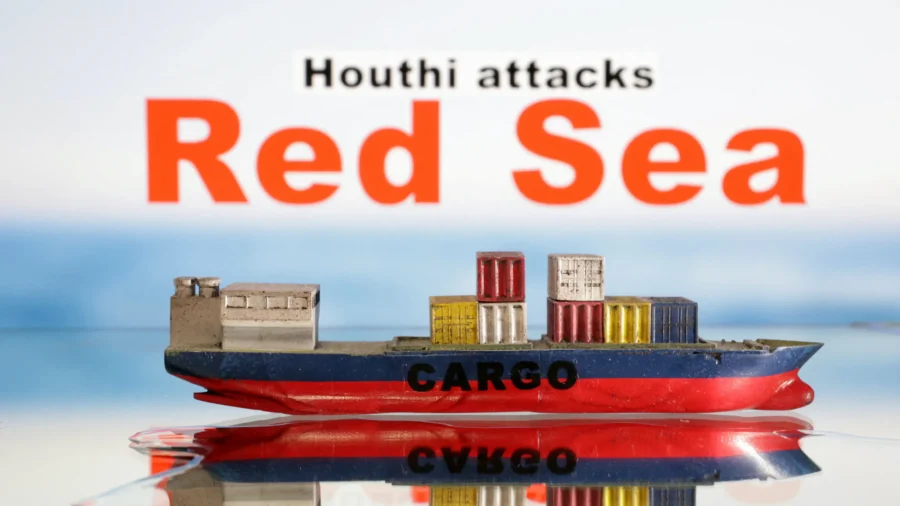The amount of cargo passing through the Suez Canal has dropped to almost half, after the Houthi attacks on ships, according to a U.N. agency.
The United Nations Conference on Trade and Development (UNCTAD) which works with developing countries in global trade, warned of risks of higher inflation, uncertainty of food security, and increased greenhouse gas emissions.
Shipping companies have diverted ships from the Red Sea since the Iran-aligned Houthi terrorist group, which controls most of the populated parts of Yemen, began attacking vessels in what it says is support of Palestinians in Gaza. The United States and Britain have responded with air strikes against the Houthis.
The agency said the number of ships transiting the canal has dropped 39 percent since the start of December, leading to a 45 percent decline in freight tonnage.
Jan Hoffmann, UNCTAD’s head of trade logistics, said that now three key global trade routes have been disrupted, including flows of grain and oil since Russia’s invasion of Ukraine. Meanwhile, low water levels last month at America’s major shipping chokepoint, the Panama Canal, resulted in shipping traffic dropping 36 percent year-on-year and 62 percent from two years ago.
“We are very concerned,” he told a briefing late on Thursday. “We are seeing delays, higher costs, higher greenhouse gas emissions.”
Shipping giant Maersk has previously suspended shipping through the Red Sea and Suez Canal “until further notice” following an attack on one of its vessels.
The Suez Canal handles 12–15 percent of global trade and 25–30 percent of container traffic. Container shipments through the canal were down 82 percent in the week ending Jan. 19 from a month prior, while for LNG, the decline was even greater. The drop-off for dry bulk was smaller and crude oil tanker traffic was very slightly higher.
Car Manufacturing Stalled
Another result of the Houthi attacks is that some car manufacturers in Belgium and Germany have been held up.
Electric carmaker Tesla was forced to halt production at its factory near Berlin from Monday to Feb. 11 because of shipment delays. Chinese-owned Swedish car brand Volvo idled its assembly line in Ghent, Belgium, where it makes station wagons and SUVs, for three days this month while waiting for a key part for transmissions.
Production at a Suzuki Motor Corp. plant in Hungary stopped for a week because of a delay in getting engines and other parts from Japan.
Houthi terrorists in Yemen, responding to Israel’s retaliation against a brutal attack by the Iran-backed Hamas terrorist group, are are attacking cargo ships plying the waters connecting Asia with Europe and the United States.
“What’s happened right now is short-term chaos, and chaos leads to increased costs,” said Ryan Petersen, CEO of supply chain management company Flexport. “Every ship that gets rerouted has 10,000 containers on it. It’s a lot of emails and phone calls getting made to replan each of those container journeys.”
Adding to the bedlam in global shipping is what Mr. Petersen calls a “double whammy” due to the Panama Canal drought. And shippers are in a rush to move goods before Chinese factories shut down for the Feb. 10–17 Lunar New Year holiday.
The threat grows considerably the longer the war in Gaza drags on. Disruption to Red Sea trade lasting a year could surge goods inflation by up to 2 percent, Mr. Petersen says, piling on pain while the world already struggles with higher prices for groceries, rent and more. That also could mean even higher interest rates, which have weakened economies.
Retail Chains Affected
British retail chain Marks & Spencer warned that the turmoil would delay new spring clothing and home goods collections that were due in February and March. Chief executive Stuart Machin said the Red Sea trouble was “impacting everyone and something we’re very focused on.”
Roughly 20 percent of the clothes and shoes imported into the U.S. arrive via the Suez Canal, said Steve Lamar, CEO of the American Apparel & Footwear Association. For Europe, the impact is even bigger: 40 percent of clothes and 50 percent of shoes traverse the Red Sea.
“This is a crisis that has global implications for the maritime shipping industry,” Mr. Lamar said.
As of Jan. 19, Flexport says, almost 25 percent of global shipping capacity is being or will be diverted from the Red Sea, adding thousands of miles and a week or two to trips.
The cost of shipping a standard 40-foot container from Asia to northern Europe has surged from less than $1,500 in mid-December to nearly $5,500. Getting Asian cargo to the Mediterranean is even costlier at almost $6,800 from $2,400 in mid-December, according to the freight booking platform Freightos.
But things could be worse. At the height of supply chain backups two years ago, it cost $15,000 to ship a container from Asia to northern Europe and nearly $14,200 to take one from Asia to the Mediterranean.
“In terms of supply chain disruptions, we’re not even close to what was happening during the pandemic,” said Katheryn Russ, a University of California, Davis, economist.
Reuters and The Associated Press contributed to this report.


